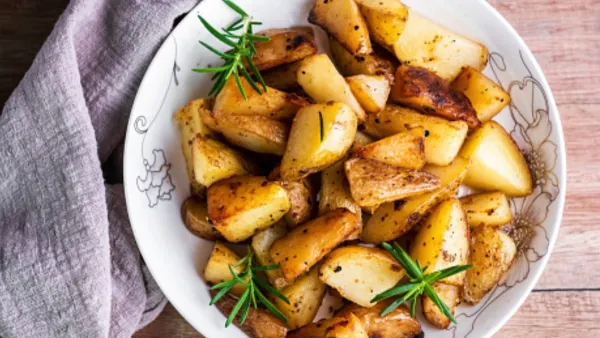
- Expert home organizers recommend matching your kitchen items to the space you have.
- Remove duplicates or unused items before adding anything new.
- After successful decluttering, spend a few minutes each week to keep your kitchen organized.
Keeping your kitchen clutter-free can feel like a never-ending job. The moment you clear one countertop, another one piles up just as quickly. If you’re losing the fight against kitchen clutter, you’re not alone. Luckily, there’s a proven strategy for decluttering kitchens that all of the home-organizing experts we spoke to recommend: match the amount of stuff in your kitchen to the storage space you have.
“I swear by letting the space set the limit by using storage space as a physical boundary,” says Julie Peaka professional home organizer and owner of the Precise Place. “When your cabinets and drawers aren’t busting at the seams, cleanup is faster, cooking feels lighter, and your kitchen becomes a space that supports you instead of stressing you out.” In this article, we speak with five home-organizing experts to show you how to apply this tip and create a more peaceful, functional kitchen.
How to Declutter Your Kitchen Based on Available Space
Maintaining a neat and tidy kitchen means decluttering regularly. This process becomes much faster and easier once you’ve scaled your kitchen items to fit the available space.
Focus on One Zone at a Time
For Justin Hammondowner of Let’s Get Moving, the best way to purge unwanted clutter is to break down your kitchen into zones. “Focus on one specific area at a time, like the utensil drawer, pantry shelf or countertop, and fully declutter it before moving on. This method prevents overwhelm, delivers visible progress quickly and supports sustained motivation.” Hammond notes that this strategy is used by home-organizing professionals certified by the National Association of Senior and Specialty Move Managers when helping clients downsize or relocate.
Identify Unused Items
Ask yourself whether you actually use each item—or if it’s just taking up space. “Go through your kitchen category by category. First all kitchen tools, then all pots and pans, then all cups, then all snacks, etc.,” says Lucy Milligan Wahla professional organizer and owner of LMW Edits. “Line everything up by type and ask yourself: Do I use this? Do I like this? If not, go ahead and donate or discard as applicable.”
“If you look at an item and say ‘I didn’t know I had that,’ it needs to go,” says Alexandrea Seminaraowner of home organization and senior relocation service Thin the Hoard. “Whether it’s a big blender or a paring knife, extra stuff that you don’t use still gets in the way.”
Set Some Ground Rules
Purging kitchen clutter involves making a lot of decisions, but a few ground rules can make the process simpler. “Get rid of any incomplete set, anything that’s broken or anything with unnecessary multiples,” recommends Emily Kate Johnsonfounder of Organized by Emily Kate. “Often, we don’t realize how much space we’re taking up with duplicate or broken items that we think we might use one day but are never actually going to pull out.”
Use Multipurpose Tools
You can save even more space—and reduce more clutter—in your kitchen by relying on utensils and appliances that serve more than one function. Peak recommends replacing multiple single-purpose tools with an item that performs both jobs. For example, using an Instant Pot rather than both a rice cooker and a pressure cooker.
More Expert Tips for a Clutter-Free Kitchen
To spruce up your kitchen to make it usable and enjoyable, here are more tips our experts recommend:
- Take photos to track your progress. Before you declutter your kitchen, snap a pic on your phone—then take another once the space looks neat, tidy and serene. “NASMM experts encourage clients to take ‘before-and-after’ photos and celebrate declutter wins to enforce good habits,” Hammond says.
- Use the four-box method to stay organized. Sort items into one of four bins: keep, donate, recycle and trash. Hammond recommends emptying each zone completely and sorting items one by one to avoid re-cluttering during a big reset.
- Clean as you go. Once you’ve emptied one area, take the opportunity to wipe down storage spaces before putting back the items you’re keeping. Clean storage containers like utensil trays and check to see if contact paper in drawers and cabinets needs refreshing.
- Make the most of vertical space. Johnson recommends adding hooks, pegs or a pot rack to walls, ceilings and even the spaces under cabinets. “This will open up more functional space within your drawers and cabinets and create new forms of storage,” she adds. “These areas are so often underutilized and can truly maximize your kitchen space.”
- Be selective about what goes on the counter. Maintain a streamlined look and free up work space by only giving items that you use regularly—like your coffee maker, toaster and fruit bowl—a space on your counter. Other appliances you use less often should be stored out of sight in a pantry, cabinet or basement.
- Consider the “one-in, one-out” rule. Once you’ve right-sized your kitchen items to fit your storage space, avoid over-accumulating or you’ll be back to square one. “When bringing in a new gadget like an air fryer, donate or relocate an old one,” Hammond recommends.
- Keep non-kitchen items out of the kitchen. If your kitchen often collects items like mail, electronics or backpacks, set up dedicated spaces for them elsewhere in the home. Collect mail and other papers in a basket in your entryway for easy sorting. Use racks, pegs or a closet for family members to stash bags and coats when they come home.
- Schedule weekly and monthly touch-ups. To keep your kitchen looking clutter-free—the hardest part—set aside time each week to tidy up countertops and other high-use areas. For lower-traffic areas, like your spice rack and pantry, schedule a monthly touch-up. This approach builds on your big reset and reinforces your new decluttering habit.
The Bottom Line
Managing kitchen clutter doesn’t have to feel impossible—it starts with matching your items to the available storage. Once you right-size your belongings to fit the space you have, keeping things tidy becomes much easier. Use strategies like zoning your kitchen, the four-box method, removing duplicates or unused items, and adding vertical storage to reset your space. After you’ve decluttered, take a little time each week to keep things looking neat, tidy and serene.
-
Vitamin B12 will increase in the body at the speed of a bullet. Just eat this dal in this manner, then vitamin B12 will not decrease

-
Potatoes are not bad for type 2 diabetes. But, here’s what you should know

-
Why the Triangle of Death on Your Face Could Be a Serious Health Threat?

-
Covid’s hidden damage: How the virus is putting women’s hearts at risk

-
Doctor Reveals 5 Simple Hacks To Boost Brain Health, Make It Sharper
